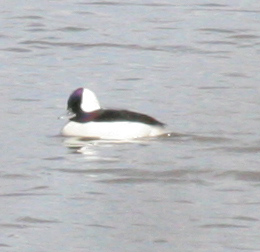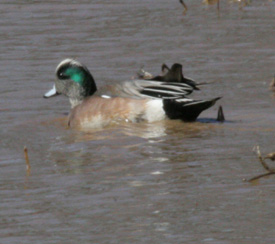Bufflehead
General:
The Bufflehead is the smallest North American diving duck. As of 2010 their population is steady. The Bufflehead nests in holes excavated by by other birds and often time by Northern Flickers

Bufflehead eggs are creamy-buff colored. The chicks hatch in approximately 29 – 31 days and fledge in 50 50 days.
Many Buffleheads are taken by hunters incidentally by hunters. These birds have a dark meat that can be strong tasting.
Identification:
Adults are approximately 13″ – 16″ long with a wingspan of 24″.
Male are black and white, with iridescent green and purple heads with a large white patch behind the eye.
Females are grey-toned with a smaller white patch behind the eye and a light underside
Habitat:
Breeds along freshwater ponds, slow rivers and small lakes. The picture was taken of a Bufflehead on the Mohawk River just outside of Schenectady, NY.
Territory:
Buffleheads breed in much of Alaska, Canada and the Northwestern USA. Ninety percent of the population is believed to breed from Manitoba westward. When Buffleheads migrate they winter in coastal waters or open inland waters on the either coast of North America and the southern United States into Mexico.
Diet:
The bird’s diet consists largely of fish and invertebrates with a lesser amount of plant material.
 because the white stripe resembles a bald man’s head. The population declined in the 1980’s as a result of drought. Since then they have steadily increased in numbers.
because the white stripe resembles a bald man’s head. The population declined in the 1980’s as a result of drought. Since then they have steadily increased in numbers.